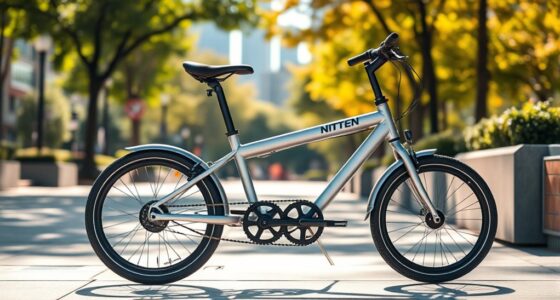Choosing between 16, 20, or 24-inch wheels depends on your driving style and preferences. Smaller 16-inch wheels offer a smoother ride and better fuel efficiency, while 20-inch wheels improve handling and make your vehicle look sportier. Larger 24-inch wheels give a bold appearance but can reduce comfort and increase road noise. Understanding how each size affects performance and aesthetics will help you make the best choice—continue to explore to find out more.
Key Takeaways
- 16-inch wheels offer a balance of comfort and efficiency, suitable for everyday driving and rough terrains.
- 20-inch wheels improve handling and appearance, often used for sporty or luxury vehicles.
- 24-inch wheels provide a dramatic look, enhancing aesthetics but may reduce ride comfort and increase road impact.
- Larger wheel sizes typically accommodate lower-profile tires, affecting ride quality and clearance.
- Compatibility with vehicle specifications is essential to avoid rubbing, miscalibration, and safety issues across these sizes.

Have you ever wondered how wheel sizes impact your vehicle’s performance and ride quality? It’s a good question, because the size of your wheels influences everything from handling to comfort. When considering wheel sizes, two key factors come into play: tire width and rim diameter. These elements work together to determine how your vehicle feels on the road, how it responds to steering inputs, and even how smooth your ride is.
Tire width is the measurement across the tire’s tread, typically expressed in millimeters or inches. A wider tire offers a larger contact patch with the road, which can improve traction, especially during cornering or acceleration. However, increasing tire width also adds weight, which might slightly reduce fuel efficiency and make steering feel heavier. Conversely, narrower tires tend to roll more easily, offering better fuel economy and a smoother ride on rough surfaces. But they may sacrifice grip and responsiveness, especially in sporty driving scenarios. When choosing tire width, you want to balance your driving style and conditions with the vehicle’s capabilities.
Rim diameter is the measurement across the wheel’s circle, usually in inches. Larger rim diameters allow for bigger tires, which can enhance the visual appeal of your vehicle and enable lower-profile tires that improve handling by reducing sidewall flex. But bigger rims also mean a firmer ride, as lower-profile tires have less sidewall to absorb shocks from bumps and potholes. Smaller rims with taller tires tend to offer a more comfortable ride, absorbing road imperfections more effectively. The rim diameter influences not just comfort but also the overall handling characteristics of your vehicle. When selecting rim size, consider how you want your vehicle to feel—sporty and responsive or smooth and comfortable.
Additionally, understanding wheel size compatibility can help prevent potential issues such as rubbing or miscalibration. It’s essential to choose a wheel size compatible with your vehicle’s specifications. Going too large or too small can negatively impact safety and performance. Larger wheels with wider tires might look impressive, but if they’re not designed for your car, they can cause issues like rubbing against the fenders or affecting speedometer accuracy. Conversely, smaller wheels might reduce handling precision and make your car look disproportionately small. Always check your manufacturer’s recommendations for tire width and rim diameter to guarantee maximum performance and safety. Upgrading wheel sizes can be tempting, but understanding how these dimensions interact helps you make smarter, informed choices that match your driving needs and aesthetic preferences.
Frequently Asked Questions
How Do Wheel Sizes Affect Vehicle Acceleration?
Larger wheels can slow down your vehicle’s acceleration because they require more torque to turn, affecting tire grip and vehicle stability. Smaller wheels, on the other hand, spin faster and respond quicker, improving acceleration. However, bigger wheels often enhance stability and handling at higher speeds. So, choosing the right wheel size balances tire grip and stability, ultimately influencing how fast your vehicle accelerates and maneuvers.
Can Changing Wheel Size Improve Fuel Efficiency?
Yes, changing your wheel size can improve fuel efficiency. Smaller wheels reduce tire grip and rolling resistance, helping your vehicle move more easily and consume less fuel. They also offer better ride comfort by absorbing road imperfections. However, larger wheels might look better but can increase resistance, reducing fuel economy. Consider balancing desired tire grip, ride comfort, and efficiency when selecting wheel sizes for ideal results.
What Wheel Size Is Best for Off-Road Driving?
Think of your vehicle as a rugged explorer ready to conquer untamed terrain. For off-road adventures, you want larger wheels that act like sturdy boots, offering better tire durability and grip. Opt for wheels that balance strength and aesthetics, so your ride looks tough yet stylish. The best size enhances traction, absorbs shocks, and withstands rough conditions—making your journey smoother and more confident on challenging trails.
How Does Wheel Size Impact Braking Performance?
Larger wheels can improve braking performance by providing better leverage and more contact with the brake pads, but they may also negatively impact aerodynamics impact and ride comfort. Smaller wheels tend to offer smoother rides and better aerodynamics, making braking feel less abrupt. Your choice affects overall safety, so consider your driving needs—larger wheels for stopping power, smaller for comfort and efficiency.
Are Larger Wheels More Prone to Damage?
Larger wheels can be more prone to damage because they often have thinner tires, which reduces tire durability. Additionally, their rims are usually larger and may be less reinforced, making them more susceptible to impact damage. You should be mindful of these factors, especially on rough roads or uneven terrain, as the combination of reduced tire durability and rim strength can increase the risk of damage to larger wheels.
Conclusion
Whether you prefer the punch of 16-inch wheels, the power of 20-inch wheels, or the wow factor of 24-inch wheels, choosing the right size depends on your driving desires. Consider your comfort, control, and style. Remember, the right wheel size transforms your ride from ordinary to outstanding. So, pick the perfect pair that fits your needs, and get ready to cruise confidently, comfortably, and coolly on the roads ahead.















